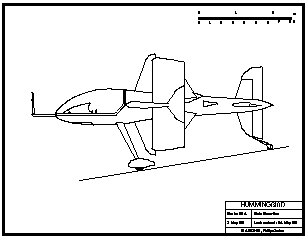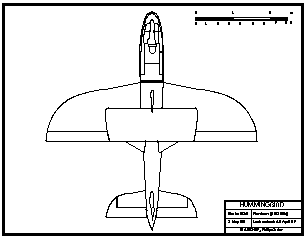
Flying Qualities
Spins
Snap Rolls
Knife-Edge (Side-Flight)
Hovering Flight/Vertical Ascents
Speed Control/Vertical Descents
Somersaults/360 degree Hammerheads
Low Speed Flight/Powered Lift
The Subjective Element
Obviously, Hummingbird will fly very differently to conventional aircraft. The aerodynamic configuration is so new and unusual that only flight testing will provide the definitive answers about handling qualities and performance, especially around stalled maneuvers such as snap-rolls and spins. Nevertheless, certain qualitative predictions can be made for a well-engineered aircraft based on the Hummingbird concept.
Conventional Maneuvers
The concentration of Hummingbird's mass over its center of gravity yields low mass moments of inertia on all axes, equating to high maneuvering rates. Along with its low wing loading, small size, high thrust-to-weight ratio and powerful control surfaces, Hummingbird will change attitude and direction more rapidly than any other man-carrying aircraft. The aircraft will fly identically upright or inverted, and identically through right-handed and left-handed maneuvers. Sequences will be flyable within a very tight area - close to judges and/or spectators if desired.
The location of the pilot ahead of the CG leads to a more direct G-force feedback. Conventional aircraft position the pilot aft of the center of gravity, so in the case of a pitch up, for instance, the pilot accelerates downwards for a moment while the aircraft is pitching, leading to a delay before the acceleration of the aircraft is felt. In other words, the perceived G forces are always slightly behind the actual acceleration of the airplane. For Hummingbird the reverse is true; a pitch up will instantly be felt as positive G, even before the aircraft has begun to accelerate.
One of the few tradeoffs implicit in the Hummingbird concept is the profile drag of the duct, ventral fins, and stators at high speeds. This is somewhat offset by the much smaller wing and low drag wing airfoils. Advanced airfoil design for all surfaces, combined with very low fuselage and parasite drag, minimize the surface area penalty. Top speeds will be considerably higher than a similarly powered aerobatic biplane, and slightly lower than those of a similarly sized and powered conventional monoplane.
It should be remembered that Hummingbird's extreme thrust-to-weight ratios will lessen the importance of high speeds. A conventional airplane requires speed so that the stored kinetic energy can be converted into potential energy, producing what is called "vertical performance". In essence, Hummingbird has more available "energy on demand," or useful power for its weight, so can rely less on stored energy. Vertical maneuvers can be entered at a lower speed, yet continued for a longer duration over greater altitude. There will be less an impression of turning speed into altitude and altitude into speed (a trademark of conventional aerobatic sequences), and more an impression of conquering gravity, both when ascending and descending.
Spins
Some qualitative predictions can be made about spin characteristics. Due to the very low mass moment of inertia on the yaw axis, the aircraft will rotate rapidly. This is advantageous, since more rotations can be completed for a given altitude loss. Furthermore, the low inertias will facilitate rapid entry into and exit out of spins. This is further assisted by the low-set rudder and the proximity of the tail surfaces to the propellers, providing prompt control response on all three axes with power, even while in the stalled condition. The cruciform empennage ensures that at least one fin/rudder is always free of blanketing from the stabilizer/elevators.
Hummingbird will have to be held in a spin with elevator, since even when the wing is fully stalled, portions of the duct surface will remain unstalled and lifting strongly. Since the duct is slightly aft of the wing, this condition will therefore trim the airplane nose down, automatically flying the aircraft out of a spin if the pilot does not make a conscious effort to hold the nose up.
Hummingbird’s friendly spin characteristics will help make it one of the safest unlimited aerobatic aircraft ever.
Snap Rolls
Much attention is being given to airfoils and planforms to ensure that an entire outboard wing will stall simultaneously with crossed controls while leaving the inboard wing and duct semi-stalled. Being circular, the duct will offer little resistance to rolling maneuvers. It is expected that snap performance will be on par with the best monoplanes.
Knife-Edge (Side-Flight)
Hummingbird's unprecedented lateral lifting surfaces facilitate unprecedented knife-edge capabilities. Efficient aerodynamic flight will be possible at any angle of bank. Moreover, the aircraft will be capable of performing knife-edge loops, rolling loops, and possibly knife-edge spins. For the first time ever, pilots will have to get used to sustained lateral G forces.
In level flight the aircraft will be able to dart left and right without banking. This lateral acceleration involves the same aerodynamics as knife-edge flight. Essentially, the airplane will go where you point it. This very characteristic could make Hummingbird rather uncomfortable to fly until one re-learns to use rudder. Hummingbird's rudder behaves more like an elevator than on previous aircraft; it produces lateral accelerations, just as an elevator produces positive and negative G.
Hovering Flight/Vertical Ascents
An optimized propulsion system and tightly engineered structure will yield an aircraft with static thrust at sea level of about 150% of aerobatic weight, with the resulting capability of maintaining a sustained hover and even a sustained vertical climb. The counter-rotating engines and propellers do away with torque asymmetries and complete three-axis control is maintained in the hover, including roll control right and left.
Transitional flight, from hover to forward flight and vice versa, promises many possibilities. Hummingbird will have available torque-free static thrust substantially exceeding aerobatic weight, and three-axis control with power at zero and low negative airspeeds. In concert with the unique interaction of the lifting and propulsion systems, many low speed transitional flight maneuvers will become possible for the first time.
Speed Control/Vertical Descents
Speed control is a further hallmark of the Hummingbird configuration. Hummingbird's advanced propulsion system will allow the aircraft to accelerate and decelerate very rapidly. At idle power and flat pitch, the six wide blades will be capable of producing significant drag forces, enhancing the airplane's ability to quickly reduce speed and make vertical descents. With the appropriate propeller control, terminal velocity will be less than Vne, thus allowing sustained vertical dives.
The location of the propellers and duct slightly aft of the CG allows the propulsion system to produce very high drag levels without loss of control. With blades flat and power off, the propulsion system will behave somewhat like a parachute, largely blocking internal airflow through the duct and consequently destroying airflow over the tail. Nevertheless, because the drag forces are applied aft of the CG, and because the airplane is relatively stable even with the tail blanketed (due to the absence of a forward engine and propeller and the location of the duct and stators aft of the CG), it is expected that the airplane will remain stable in a vertical dive even with the tail blanketed. The elevator tips will always be clear of blanketing, while the duct, stators, and winglets all help maintain directional stability. Full stability and control will be regained as soon as power is applied.
Somersaults (360-degree Hammerheads)
No airplane has been able to flip from a nose-up attitude through 360 degrees longitudinally and return to its original condition. Even model airplanes pick up too much downward velocity as the nose passes through 180 degrees to be able to hold the maneuver at 360 degrees; the best they can do is maintain the rotation through 540 degrees and fly out of it.
Hummingbird's hover capability, together with the proximity of the tail surfaces to the propellers, should make such somersaults possible.
Applying full elevator or rudder in the hover will rotate the airplane rapidly around its CG. As the nose passes through 90 degrees the airplane will accelerate horizontally, then rapidly downwards as the nose passes through 180 degrees. Here the key will be to maintain the rotation by keeping power on to maintain airflow over the tail. As the nose rotates back to vertical (360 degrees) the airplane will be descending rapidly—flying backwards! However, since the propeller blast is exiting the duct less than five feet forward of the tail surfaces at about 100 mph, sufficient airflow will be maintained over the tail (with the associated control) up to some limiting backwards airspeed, allowing the pilot to maintain control and arrest the descent up to that airspeed. Thus it is expected that with suitable pilot technique it will be possible to somersault the aircraft in either pitch or yaw.
Low Speed Flight/Powered Lift
Hummingbird has a further trick up its sleeve resulting from the duct’s double duty as wing and propeller shroud. At low speeds and high angles of attack, power on, a large mass of air is passing through the duct. The high angle of attack will cause the airflow to enter the duct asymmetrically, resulting in a net lifting force as the airflow accelerates around the inboard wing and lower inlet. This effect is analogous to passing accelerated air over the upper surface of an airplane wing, sometimes called “powered lift”.
The unique aerodynamic coupling of Hummingbird’s propulsion and lifting systems will allow extremely slow forward flight at high angles of attack, perhaps giving the impression of levitation. While the effect is difficult to accurately model, slow flight will likely be the most intriguing mode of Hummingbird flight—and the most responsive to pilot skill.
The Subjective Element
Competition aerobatics contains a significant subjective element; the look and sound of an airplane in the air can color the scoreboard almost as much as the maneuvers flown. Similarly, certain airshow aircraft excite and capture the imagination more than others. In this sense, Hummingbird is quite simply unique; the aircraft will look and sound completely different to anything that has come before it. While developed from functional considerations, Hummingbird looks like it has flown out of the 21st century, while the 190 Hz rumble from the slow-turning, ducted propellers will create a unique sound likely to become its trademark.
However the Sport of Aerobatics might hesitate to let such an upstart undermine its time-honored traditions, experience tells us that familiarity ultimately breeds acceptance. Judges and spectators will soon get used to the Hummingbird look and sound when it becomes apparent that it flies aerobatics better than anything else in the sky. If Hummingbird performs as expected, our subjective impressions will soon adjust, first to accept it, and ultimately to expect it.
Pilots, too, will take time to get used to the new capabilities of the aircraft. There will be a period of coming to terms with what the aircraft can do, a rethinking of how aerobatics can or should be flown. Aerobatic sequences will evolve to take advantage of these new capabilities. It can be expected that the superb visibility, attitude reference, performance, quiet cockpit, and safety will soon make the aircraft a favorite with pilots.



© Copyright 1992-2009 Philip Carter

